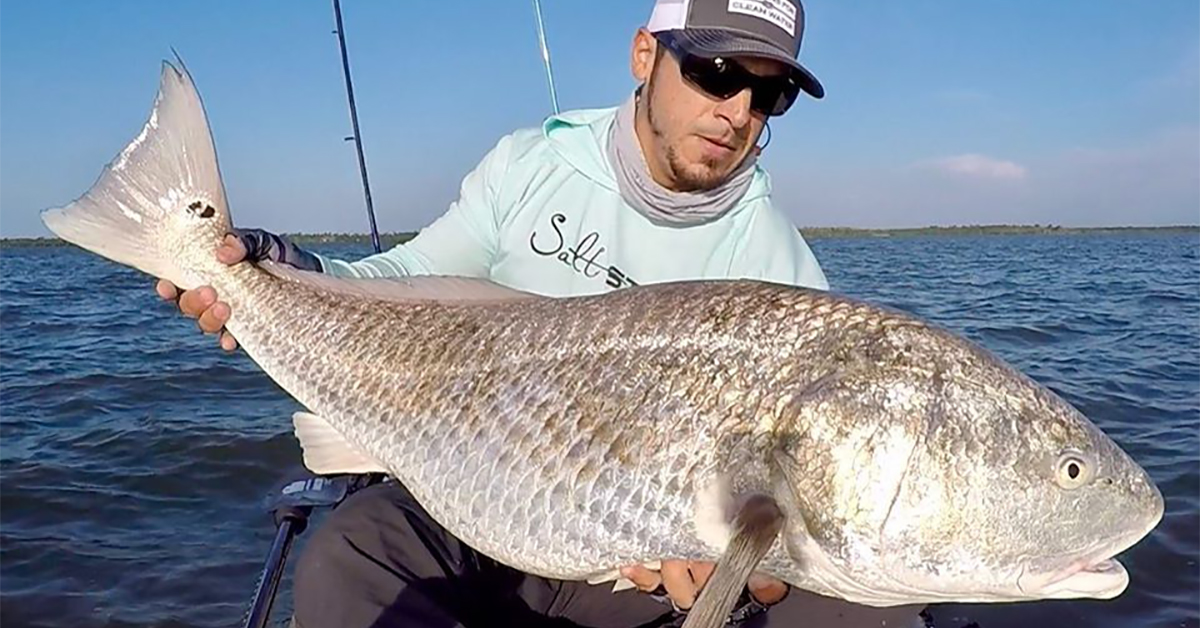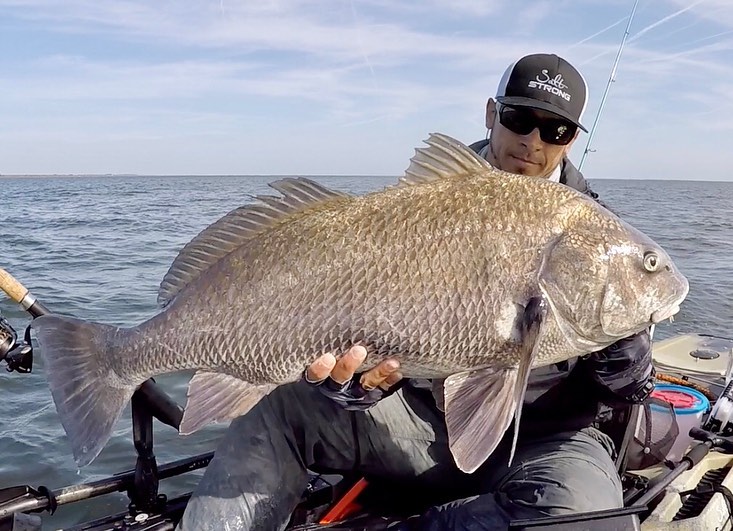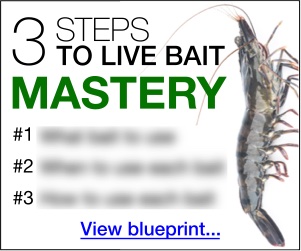How To Catch Big Redfish, Black Drum, & Snook On Light Tackle
- By: Tony Acevedo
- on

Have you ever had a big fish on the line, but they got off?
Most anglers have, and if you haven’t, it’s only a matter of time…
There’s a fine line between personal best and heartbreak here, and any mistake with a big fish on could be disastrous.
So in this video, I’m going to show you how to avoid those mistakes and land big fish on light tackle.
Check it out below.
How To Catch Big Fish On Light Tackle [VIDEO]

Before we get into how to land these big fish, I want to throw out a disclaimer.
I know some people will say that you shouldn’t target big fish on light tackle, but sometimes you stumble across them and only have light tackle on hand.
Other times, you may be caught by surprise and instead of the 15-inch trout that you were expecting, you’ve got a 40-inch snook on the line.
So these tips will help you land those fish in as little time as possible and safely release them.
Tip #1: Be prepared with the proper equipment
If you’re fishing areas with structure like docks, bridges, or jetties, be sure to have heavier tackle so that the fish can’t drag you into the structure right away and break you off.
Be equipped with 20-30 lb line and 40-60 lb leader in this areas.
If you’re fishing the flats where there’s a lot of room for the fish to run, this is not as important (I’ve caught 45-inch redfish on 10 lb braid and 20 lb leader and got them in in about ten minutes).
Tip #2: If they run, let them run
Don’t put too much pressure on a fish, especially on tarpon and snook because they have rough mouths that can rub right through your leader.
Also, be careful at the beginning and end of the fight, since these are the times where people may get caught off guard.
Tip #3: Loosen your drag as the fish gets closer to the boat
You’ll have less line out at this point, so there will be a lot more pressure on your line.
One thing I sometimes do is use my palm to palm the spool to slow a fish down.
I’d rather have my drag too loose and use my palm to add pressure, than have the drag too tight and risk the fish popping off.
Tip #4: Make sure the drag is set properly
If it’s too loose, you won’t have enough pressure to set the hook, and if it’s too tight, you may get broken off when the fish runs.
The “proper” drag setting is 20% to 30% of your weakest line’s strength.
So if you’re using a 10 lb test mainline and a 20 lb leader, your drag should be set at 2 to 3 pounds (directly leaving the reel).
Click here for more details on drag tension.
Tip #5: If you need to chase the fish, do it!
Whether you need to chase them down a flat or around docks, be open to chase down a fish.
I recently had to chase a snook under and through dock pilings.
It was a beast of a snook and a really fun fight— you can watch that video here.
Tip #6: Whichever direction the fish runs, pull in the opposite direction
If the fish runs to the left, pull to the right.
This will help wear them out quickly.
Tip #7: Keep your rod tip low
By keeping your rod tip low, you’ll encourage them to keep their head in the water.
Fish often spit the hook when their heads break the surface.
Conclusion

When you’re fishing inshore, you never know what’s going to hit your bait.
Whether it’s a big redfish, snook, black drum, or tarpon, if you follow the tips above you can give yourself a good shot at landing them, even on light tackle.
Have any questions about catching big fish on light tackle?
Let me know in the comments below.
And if you know someone who’s gotten their heart broken by a big fish, please TAG or SHARE this with them!
P.S. People have been catching a TON of big fish on the Slam Shady paddletail. Click here to try out a pack for FREE!
Stop Wasting Time On The Water!
Do what the “SMART ANGLERS” are doing and join the Insider Club.
Here’s what you’ll receive today when you join:
- Weekly fishing reports and TRENDS revealing exactly where you should fish ever trip
- Weekly “spot dissection” videos that walk you through all the best spots in your area
- Exclusive fishing tips from the PROS you can’t find anywhere else
- Everything you need to start catching fish more consistently (regardless if you fish out of a boat, kayak, or land).
Click here to join today.
Related articles:
Related categories:
STOP WASTING TIME ON THE WATER!
Do what the “SMART ANGLERS” are doing and join the Insider Club.
Here’s what you’ll receive today when you join:
- Weekly fishing reports and TRENDS revealing exactly where you should fish every trip
- Weekly “spot dissection” videos that walk you through all the best spots in your area
- Exclusive fishing tips from the PROS you can’t find anywhere else
- Everything you need to start catching fish more consistently (regardless if you fish out of a boat, kayak, or land).










Tony, Very good. You have many great tips. Very helpful. Thank you, Tom Watts, Naples
No problem Tom! Thank you for the great feedback!
Great tips Tony. I will endeavor to keep my rod tip lower after viewing this video
Thanks David!
Thanks Tony, good info. One thing I have found interesting and will use in my fishing techniques is (a) manually flipping the bail closed after casting with a spinning rod/reel set up, and (b) using my hand to add drag (like I would with my fly rod (never had thought of that for an open face). When salmon fishing up in the Queen Charlotte Islands a couple times in 2000 and 2001, the Canadians had these “mooching reels” (aka: knuckle busters) which were very effective for catching massive Chinooks, Cohos, and Pinks (ocean fishing when they are munching on schools of herring and “fattening up” vs. rivers when they are spawning). We were dropping baits down 180 to 230 feet . Similar technique, using your hand to “drag” the reel. When a 40 or 50+ pounder hit – you let’em run and enjoy the ride. Thanks for the reminder – hadn’t thought of that in years.
No problem William!
Great info as always. You appear much more confident and poised since you started doing these videos. Keep up the good work.
Thanks Sam! It’s definitely a little easier after a couple hundred videos haha. Appreciate the great feedback!
Great points Tony! I frequently are reminded of things I’ve begun to overlook, but always learn something new from your videos.
One thing I might add, when horsing a big fish in, the more times he turns away and runs, the more abrasion there is on the line
at his mouth. I try initially to wear him down slowly and then once he is facing me, I try to keep steady pressure to reduce the
number of turns.
Thanks again,
Thanks John! Great point as well. 100% of the snook i lose are when they turn and take off. Also, the longer i fight the fish, the more and more I loosen the drag to reduce pressure.
I’ve heard the lower the line on the spool. Don’t increase drag because the lower it get the more drag? So if u were using a 4/0 penn for shark or tarpon when your almost spooled the drag has already been increased so don’t tighten the drag
Interesting. I haven’t heard of that. From what I have experienced, the more line you have out, the more play you have in your line. The less line you have out, the less play and more pressure which is where you will typically lose the fish and pop the line. So it would almost be opposite of what you mentioned. I’ll be sure to look into it! I have an experiment in mind that could test that out.
A fish pulling line, or a person pulling line off the spool, is a linear force. Are we calling this linear force “drag” ?
The actual turning of the spool, against the “brake” (which we also call a “drag washer” or “drag disc”) is really torque. The definition of torque is a force applied about a radius or a pivot point.
The distance from the top of the spool of line, to the centerline of the spool, is the radius or the “lever arm” that was described earlier.
When the lever (or star) controlling the drag is set at one point, the torque required to turn the spool does NOT change as line is pulled out (assuming no changes from heat or other changes in the mechanical system).
In simple math, if the radius of a full spool is 2 inches and it requires 5 pounds of linear force (as seen on a spring scale) to overcome the (lever, star) drag setting, and then enough line is peeled off such that the radius of the spool is now one inch, it will required 10 pounds of linear force to overcome the same drag setting.
In both cases, the torque to overcome the drag setting is 10 inch / pounds (or pound / inches depending on nomenclature used).
So in a way, the reel specs would be more meaningful, more specific, if they were given in torque. Since they insist on using “pounds of drag” they should specify the radius, or “how full is the spool”.
So I went back and found a few boards talking about it and it seems that they compare more line on a spool is equal to grabbing a 12” wrench at the end trying to break a nut loose as compared to almost being spooled would be like grabbing the wrench towards the bottom. So the drag/ torque the spool has to overcome is like using a breaker bar. Being the breaker bar would be the full spool. Some people say they used a spring scale to test it but who knows if they did it or did it right get the correct result. Maybe this is a quarantine mythbuster. Wild make a cool video if you guys did it I’d trust your results.
Nice Tony, good video……I gotta get over there and try out those big ones! I have fished Haulover once wadeing. Next time bring the camper and boat to put in the time to find em.
Thanks David! Haulover is great for the big ones!
Great info thanks Tony
No problem Joe!
great tip thanks
No problem Tony!
Great tips and video Tony! For kayak anglers, I would also recommend to let the fish run and tow you (assuming there’s room). We call it the Texas sleigh ride. Make sure to keep you rod tip facing to the front. Longer rods (7’+) help in this case.
Thanks Jonathan! Yep that’s also a good technique, but situational in some cases. If the fish is pulling me to structure I may just hop out or try to put the brakes on.